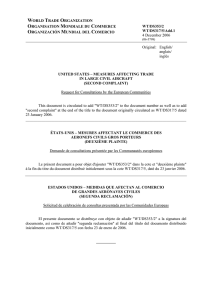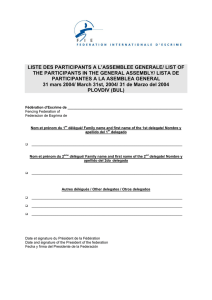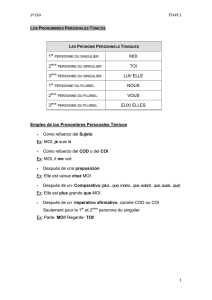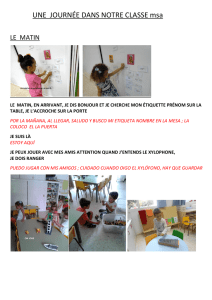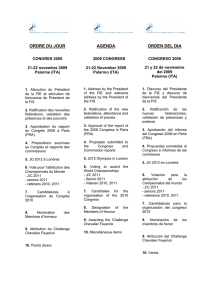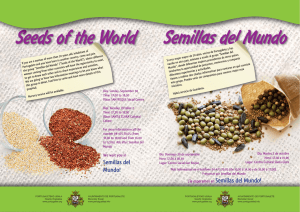NHK World Heritage 100 Series
Anuncio
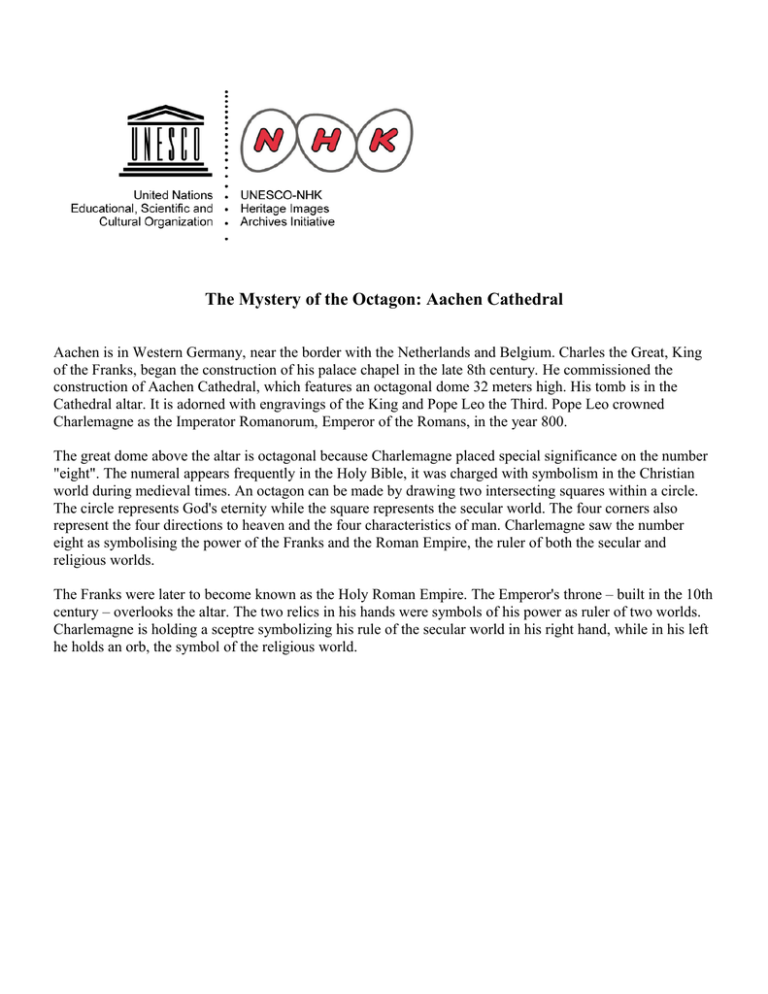
The Mystery of the Octagon: Aachen Cathedral Aachen is in Western Germany, near the border with the Netherlands and Belgium. Charles the Great, King of the Franks, began the construction of his palace chapel in the late 8th century. He commissioned the construction of Aachen Cathedral, which features an octagonal dome 32 meters high. His tomb is in the Cathedral altar. It is adorned with engravings of the King and Pope Leo the Third. Pope Leo crowned Charlemagne as the Imperator Romanorum, Emperor of the Romans, in the year 800. The great dome above the altar is octagonal because Charlemagne placed special significance on the number "eight". The numeral appears frequently in the Holy Bible, it was charged with symbolism in the Christian world during medieval times. An octagon can be made by drawing two intersecting squares within a circle. The circle represents God's eternity while the square represents the secular world. The four corners also represent the four directions to heaven and the four characteristics of man. Charlemagne saw the number eight as symbolising the power of the Franks and the Roman Empire, the ruler of both the secular and religious worlds. The Franks were later to become known as the Holy Roman Empire. The Emperor's throne – built in the 10th century – overlooks the altar. The two relics in his hands were symbols of his power as ruler of two worlds. Charlemagne is holding a sceptre symbolizing his rule of the secular world in his right hand, while in his left he holds an orb, the symbol of the religious world. Le mystère de l'Octogone : la Cathédrale d'Aix-la-Chapelle Aix-la-Chapelle se trouve en Allemagne occidentale, près de la frontière des Pays-Bas et de la Belgique. Charlemagne, roi des Francs, entreprit la construction de la chapelle palatine à la fin du 8ème siècle. Elle fait partie de la cathédrale d'Aix-la-Chapelle, et elle est surmontée d'un dôme octogonal de 32 mètres de haut. Le tombeau du roi se trouve dans le chœur de la cathédrale. Il est orné de gravures représentant le roi et le pape Léon III. C’est lui qui avait couronné Charlemagne comme l'Imperator Romanorum, Empereur des Romains, en l'an 800. Le grand dôme au-dessus de l'autel, est octogonal parce que Charlemagne accordait une signification particulière au chiffre "huit". Ce chiffre apparaît fréquemment dans la sainte Bible. Il était chargé de symboles dans le monde chrétien médiéval. Un octogone peut être tracé en dessinant deux carrés qui s’entrecroisent à l'intérieur d'un cercle. Le cercle représente l'éternité de dieu, tandis que le carré représente le monde laïc. Les quatre coins représentent aussi les quatre directions qui mènent au ciel et les quatre caractéristiques de l'homme. Charlemagne a vu le chiffre huit, comme symbole du pouvoir des Francs et de l'Empire romain, et comme symbole du maître des mondes laïques et religieux. Le royaume des Francs allait devenir plus tard le Saint Empire romain germanique. Le trône de l'Empereur, construit au 10ème siècle, surplombe l'autel. Les deux reliques qu’il tient dans ses mains étaient les symboles de son pouvoir en tant que maître des deux mondes. Charlemagne tient dans sa main droite le sceptre qui symbolise son autorité sur le monde séculier, et dans sa main gauche, l’orbe, qui représente le monde religieux. UNESCO/NHK Videos on Word Heritage sites El misterio del octógono: la catedral de Aquisgrán Aquisgrán es una ciudad del oeste de Alemania, cerca de la frontera con los Países Bajos y Bélgica. Carlomagno, rey de los francos, comenzó la construcción de la capilla de su palacio al final del siglo VIII. Él ordenó la construcción de la catedral de Aquisgrán, que incluye una cúpula octogonal de 32 metros de altura. Su tumba se encuentra en el altar de la iglesia. Está adornada con grabados del Rey y del Papa León III. De hecho, éste coronó a Carlomagno como el “Imperator Romanorum”, emperador de los romanos, en el año 800. La gran cúpula sobre el altar es octogonal porque Carlomagno le daba gran significación al número 8. Este número, que aparece varias veces en la Biblia, estaba cargado de simbolismo en el mundo cristiano durante el medioevo. Un octógono se puede lograr al dibujar dos cuadrados que se interesectan dentro de un círculo. El círculo representa la eternidad de Dios, mientras el cuadrado representa el mundo seglar. Las cuatro esquinas representan también las cuatro direcciones al cielo y las cuatro características del hombre. Carlomagno vio el número 8 como un símbolo del poder de los francos y del Imperio romano, que gobernaba tanto el mundo seglar como el religioso. Los francos constituirían lo que más tarde se conoció como el Sacro Imperio Romano. De hecho, el trono del emperador, construido en el siglo X, mira hacia el altar. Las dos reliquias en sus manos eran el símbolo de su poder como gobernante de dos mundos. Carlomagno tiene en su mano derecha un cetro que simboliza su poder sobre el mundo profano y en su mano izquierda lleva un orbe, el símbolo del mundo religioso. سر الم&ثم%ن :كاتدرائية آخن Aachen تقع مدينة آخن في غرب ألمانيا على الحدود مع هولندا وبلجيكا .وقد بدأ شارل الكبر ،ملك الفرنكيين Franksبناء كنيسة قصره في أواخر القرن الثامن وأمر بتشييد كاتدرائية آخن التي تعطي أهمية خاصة للقبة ذات الزوايا والضلع الثمانية والتي يبلغ ارتفاعها 32مترا> .مقبرته في مذبح الكاتدرائية .وهي مزدانة بنقوش للملك والبابا ليو Léoالثالث. فقد توج البابا ليو الثالث شارلمان كإمبراطور روماني في عام ثمانمائة. القبة الضخمة الواقعة فوق المذبح ذات ثماني زوايا لن شارلمان أولى أهمية خا صة للرقم ثمانية .ويتكرر الر قم في الكتاب المقدس وكان محمل> بالرمزية في العالم المسيحي في العصور الوسطى .والم9ث م^ن يمكن تكوينه برسم مربعين مت قاطعين في ن طاق دائرة .وتم ثل ا لدائرة البد ية الله ية بين ما يم ثل المر بع ال عالم ا لدنيوي .ك ما تم ثل الركان الرب عة التجاهات الربعة الموصلة إلى السماء والخصائص الربع للنسان .واعتبر شارلمان الرقم ثمانية رمزا> لقوة الفرانكيين والمبراطورية الرومانية ،الحاكمة لكل من العالمين الدنيوي والديني. وأصبح الفرانكيون يع9رفون فيما بعد باسم المبراطورية الرومانية المقدسة .وعرش المبراطور –الذي ب9ني في القرن العاشر -يطل على المذبح .وكان يرمز الثران المقدسان في يديه إلى سطوته كحاكم لعالمين .وكان شارلمان يمسك صولجانا> يرمز إلى حكمه للعالم الدنيوي في يده اليمنى ،بينما ي9مسك في يده اليسرى كرة ،رمز العالم الديني. UNESCO/NHK Videos on Word Heritage sites
